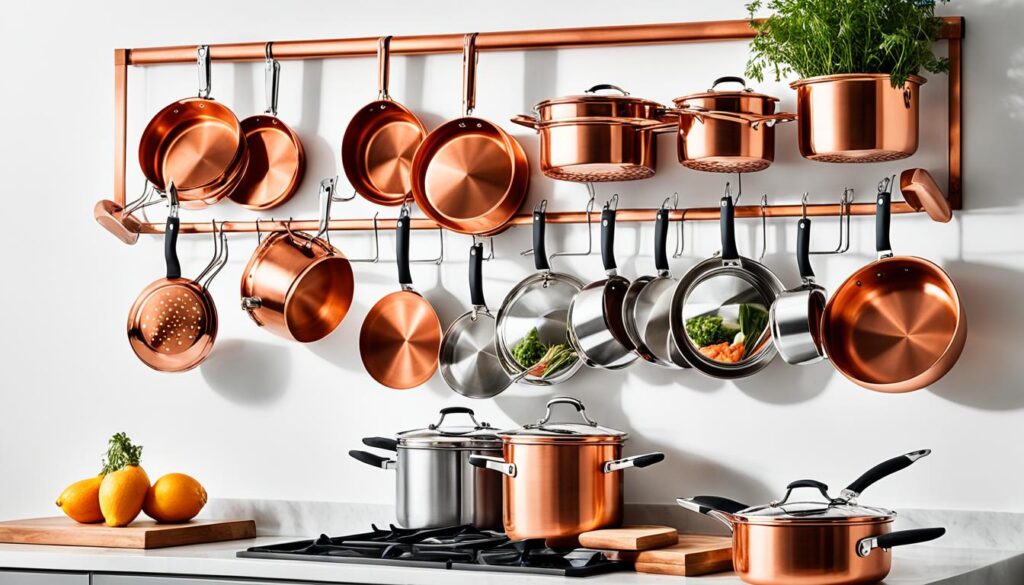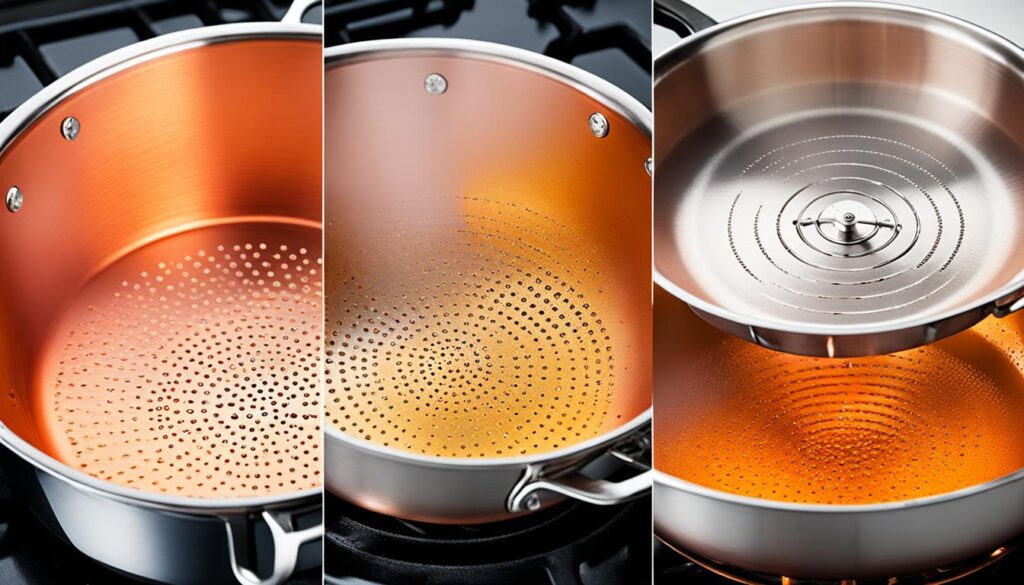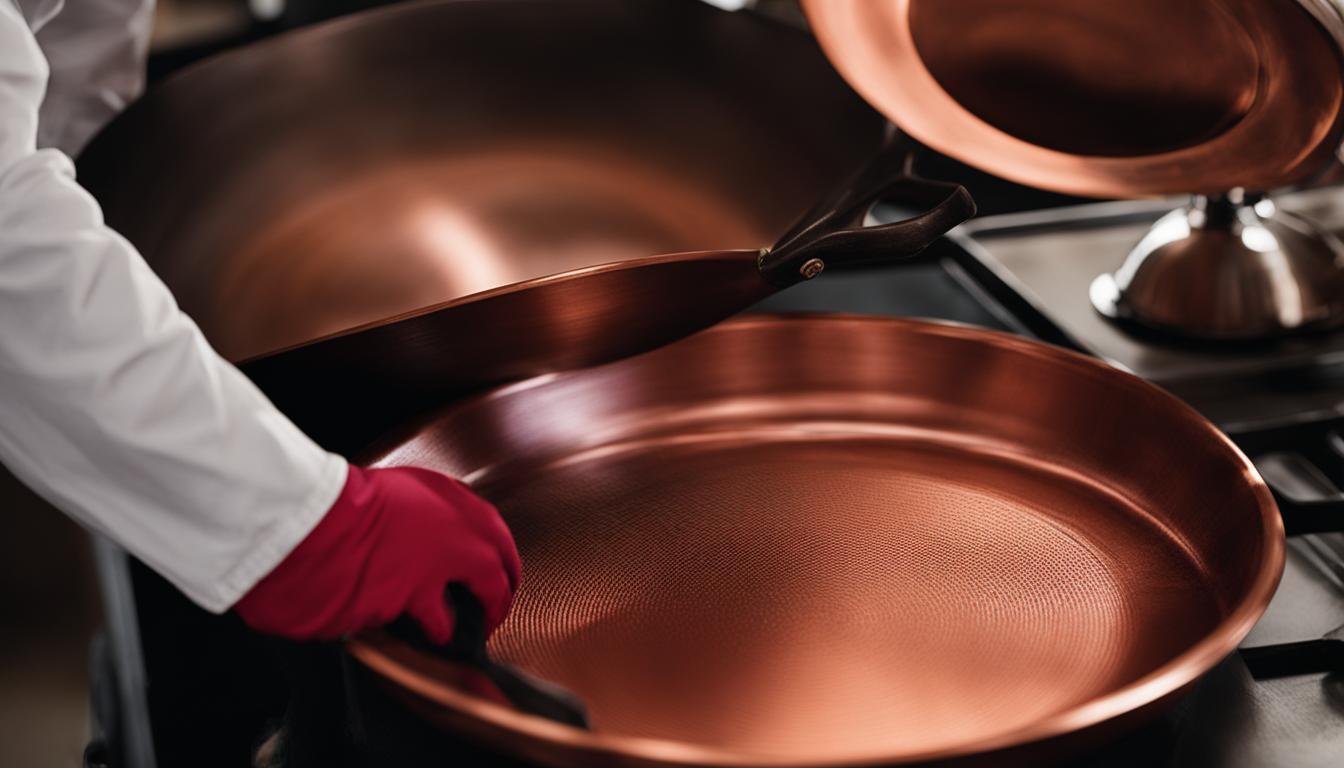Welcome to our care guide for maintaining copper pots and pans. In this article, we will provide you with the best practices for taking care of your copper cookware, including cleaning, seasoning, and storing tips. By following these guidelines, you can ensure the longevity and performance of your copper pans, allowing you to enjoy their superior heat conductivity and even heating surface for years to come.
How to Polish Copper Cookware
Routine polishing is essential to maintain the shine of your copper cookware. Over time, copper pans can develop a tarnished or dull appearance due to exposure to air and moisture. To restore their lustrous shine, follow these simple steps to polish your copper cookware.
DIY Copper Polish
One effective and budget-friendly way to polish copper cookware is by using a homemade abrasive paste. Here’s how:
- Mix equal parts lemon juice and table salt to form a paste.
- Apply the paste to the tarnished areas of the copper cookware.
- Gently rub the paste onto the surface using a soft cloth or sponge.
- Rinse the cookware thoroughly with warm water.
- Dry the copper cookware with a clean, dry cloth.
This DIY copper polish can effectively remove tarnish and restore the shine to your cookware. Remember to test the paste on a small inconspicuous area first to ensure compatibility with your copper pans.
How Often to Polish Copper Cookware
The frequency of polishing your copper cookware depends on personal preference. If you prefer a like-new appearance, it is recommended to polish your cookware every six months. However, some cooks embrace the natural patina that develops on copper pans over time and choose to polish less frequently.
Did you know? Tarnishing is a natural reaction between copper, water, and air. It does not affect the performance of the cookware but can impact its appearance.
Cleaning Tips for Polished Copper Cookware
Once you’ve polished your copper cookware, it’s important to maintain its shine. Here are some cleaning tips to keep your cookware looking its best:
- Always hand-wash your copper cookware with warm, soapy water and a soft sponge.
- Avoid using abrasive cleaners or scouring pads, as they can damage the polished surface.
- To remove water spots, buff the copper surface with a soft cloth dampened with a small amount of olive oil.
- Store your polished copper cookware in a cool, dry place to prevent tarnishing.
Tips for Copper Cookware Maintenance
Proper care and maintenance are essential to ensure the longevity and performance of your copper cookware. Here are some important tips to follow:
Storing Copper Cookware
Storing your copper cookware correctly is crucial to prevent oxidation and maintain its quality. It is recommended to store copper cookware in a cool, dry space away from humidity. Avoid exposing it to direct sunlight or extreme temperatures. To prevent scratches and damage, consider using protective felt or cloth liners between the pans.
Avoiding Acids in Copper Cookware
Copper cookware reacts negatively with acidic ingredients, which can cause the formation of toxins and affect the taste of the food. Avoid cooking or storing acidic foods like lemons, tomatoes, or vinegar in copper pots and pans. Instead, opt for stainless steel or non-reactive cookware for acidic dishes. It is also important to note that copper pots lined with stainless steel or tin are more resistant to acid reactions.
Using Correct Utensils with Copper Cookware
To preserve the pristine surface of your copper cookware, it is crucial to use the right utensils. Avoid using metal utensils that can scratch the copper lining. Instead, opt for wooden spoons, silicone spatulas, or nylon utensils that are gentle on the surface. Not only will this help maintain the cookware’s appearance, but it will also prevent metal from leaching into the food.
| DOs | DON’Ts |
|---|---|
| Store in a cool, dry place | Expose to direct sunlight or extreme temperatures |
| Use non-reactive cookware for acidic ingredients | Cook or store acidic foods in copper cookware |
| Use wooden, silicone, or nylon utensils | Use metal utensils that can scratch the surface |
By following these maintenance tips, you can ensure that your copper cookware remains in optimal condition and continues to provide you with exceptional cooking performance for years to come.

Understanding Copper Cookware
Copper cookware is highly sought after for its numerous advantages and unique characteristics. Let’s explore the benefits of using copper cookware, the different types available, the beautiful patina it develops over time, and its heat sensitivity.
Advantages of Copper Cookware
Copper cookware offers exceptional heat conductivity, allowing for precise temperature control and even heat distribution.
Copper pans heat up quickly and respond rapidly to changes in heat levels, giving cooks greater control over their cooking process. This enables faster cooking times and more precise results.
Types of Copper Cookware
Copper cookware comes in various types to suit different cooking needs and preferences:
| Type | Features |
|---|---|
| Tin-lined copper cookware | Traditional and provides excellent heat conductivity. Requires regular re-tinning for maintenance. |
| Stainless steel-lined copper cookware | Combines the heat conductivity of copper with the durability and easy maintenance of stainless steel. |
| Unlined copper cookware | Showcases the natural beauty and aesthetic appeal of copper. Requires frequent polishing to maintain its shine. |
The Patina of Copper
Over time, copper cookware develops a unique patina, which is a thin layer that forms on the surface of the metal.
The patina can range from a rich reddish-brown to a deep green color, imparting a rustic charm to the cookware. Some cooking enthusiasts embrace and appreciate the patina as it adds character and reflects the history of the cookware.
If you prefer a pristine, shiny appearance, the patina can be removed through regular polishing.
Heat Sensitivity of Copper Cookware
Copper cookware is highly heat sensitive, requiring careful usage and maintenance to prevent damage to the lining and handle.
Extreme heat can cause warping, discoloration, and even melting of the lining materials. It is essential to avoid sudden temperature changes and excessive heat exposure.
To protect your copper cookware, use low to medium heat settings and avoid using it on induction stovetops.

By understanding the advantages of copper cookware, the various types available, the unique patina it develops, and its heat sensitivity, you can make informed decisions and enjoy cooking with this versatile and beautiful material.
Daily Cleaning Techniques
When it comes to maintaining the shine and performance of your copper cookware, daily cleaning is key. Follow these simple techniques to keep your copper pots and pans looking their best.
Cleaning with Warm, Soapy Water
Start by rinsing your copper cookware with warm water to remove any food particles. Then, using a soft sponge or cloth, apply a small amount of mild dish soap and gently scrub the surface of the cookware. Rinse thoroughly with warm water to ensure all soap residue is removed, and pat dry with a clean towel.
Natural Cleaning Agents for Tough Stains
If your copper cookware has stubborn stains or discoloration, try using natural cleaning agents. Lemon juice and baking soda or a mixture of vinegar and salt can be effective in removing tough stains. Create a paste by mixing these ingredients together and apply it to the affected area. Allow it to sit for a few minutes, then rinse with warm water and dry.
Removing Water Spots
Water spots can sometimes form on copper cookware, leaving unsightly marks. To remove these spots, dampen a soft cloth with olive oil and gently buff the affected areas. The oil will help dissolve the spots and restore the shine of your cookware. Once the spots are removed, wash the cookware as usual and dry thoroughly.
Preventing Tarnish and Oxidation
To keep your copper cookware looking its best, it’s important to prevent tarnish and oxidation. After washing, make sure to dry your cookware thoroughly to eliminate any moisture that can cause tarnish. Additionally, storing your copper cookware in a cool, dry place can help prevent oxidation. Taking these simple steps will ensure your copper cookware stays clean and beautiful for years to come.
